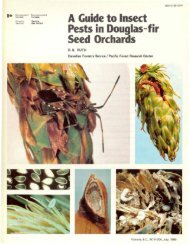seeding jack pine on the sandilands forest reserve, manitoba 1925 ...
seeding jack pine on the sandilands forest reserve, manitoba 1925 ...
seeding jack pine on the sandilands forest reserve, manitoba 1925 ...
Create successful ePaper yourself
Turn your PDF publications into a flip-book with our unique Google optimized e-Paper software.
CANADA<br />
Department of Nor<strong>the</strong>rn Affairs and Nati<strong>on</strong>al Resources<br />
FORESTRY BRANCH<br />
SEEDING JACK PINE ON THE<br />
SANDILANDS FOREST RESERVE, MANITOBA<br />
<strong>1925</strong> TO 1955<br />
by<br />
J. H. Cayford<br />
Forest Research Divisi<strong>on</strong><br />
Technical Note No. 79<br />
1959<br />
73580-3-1
Issued under <strong>the</strong> authority of<br />
The H<strong>on</strong>ourable Alvin Hamilt<strong>on</strong>, P.C., M.P.,<br />
Minister of Nor<strong>the</strong>rn Affairs and Nati<strong>on</strong>al Resources<br />
Ottawa, 1959<br />
THE QUEEN'S PRINTER AND CONTROLLER OF STATIONERY<br />
OTTAWA, 1959<br />
Cat. No. R47-79
CONTE TS<br />
PAGE<br />
INTRODUCTION. . . . . . . . . . . ... . .. . . . . . . . . . . . . . . . .. . . . . . . . . . . . . . . . . • • 5<br />
DESCRIPTION OF PLOTS SEEDED.... ..... .................... ... .. . . 5<br />
SEEDING METHODS . . . . . . . . . . . . . . . . . . . . . . . . . . . . . . . . . . . . . . . . . . . . . . . : 5<br />
SAMPLING METHODS . . . . . . . . . . . . . . . . . . . . .. . . . . . . . . . . . , . . . . . . . . . . . . 6<br />
RESULTS . . . . . . . , ...................................... , ,......... 6<br />
Experimental Seeding, <strong>1925</strong> to 1928 ......... ,................ .. . 6<br />
Broadcast Seeding, 1943 ..,.............................. ,..... 8<br />
Broadcast Seeding, 1945 ........... ,... ,................ , ,..... 9<br />
Broadcast Seeding, 1950 to 1955 ...................... ,.. ,...... 9<br />
Scattering of C<strong>on</strong>es, 1953 and 1954. ,.............. ............. 12<br />
Seeding in Furrows, 1952. ............ .................... ..... 12<br />
FACTORS THAT AFFECTED RESULTS . . .. , ............................ 12<br />
Time of Seeding ... , . . . . . . . . . . . ., . . ., . . . . . . . . . . . . . . .. . .. . . . . . . 1 2<br />
Scarificati<strong>on</strong> . . . . . . . . . .. . . . . . . . . . . . . . . . . . . . . . . . . , . . . . . . . . . . . .. 12<br />
Lesser Vegetati<strong>on</strong> . . . . .. . . .. . . . . . , . . . . . . . . . . . . . . . . . . . . . . . . . . . .. 13<br />
Seed . . , . , .......... , .............. , ... , .... , .............. '. 14<br />
Biotic Factors .. . , . , ............ , . . . . . . . . . . . . . . . . . . . . . . . . . . . .. 14<br />
SUMMARy . . . . . " ..... " .,........................................ 15<br />
REFERENCES .. .. . . . . . . . , . . . . . . . . . . . . . . . . . . • . . . . . . . . . . . . . . . . . . . . .. 15<br />
ApPENDIX... ... . . . . . . . . . . . . . . . . . . . . . . . . . . . . . . . . . . . . . . . . . . . . . . . . . . 16<br />
73580-3-1!<br />
3
ACK<br />
OWLEDGEME IT<br />
The author wishes to express his gratitude to <strong>the</strong> Manitoba Forest Service<br />
for permissi<strong>on</strong> to use <strong>the</strong>ir records pertaining to <strong>the</strong> <str<strong>on</strong>g>seeding</str<strong>on</strong>g>. Foresters M. Kaye<br />
and A. Kotowycz provided c<strong>on</strong>siderable assistance in planning and carrying out<br />
<strong>the</strong> field examinati<strong>on</strong>.<br />
4
Seeding Jack Pine <strong>on</strong> <strong>the</strong> Sandilands Forest Reserve,<br />
Manitoba, <strong>1925</strong> to 1955<br />
by<br />
J. H. Cayford1<br />
INTRODUCTION<br />
Direct <str<strong>on</strong>g>seeding</str<strong>on</strong>g> with <str<strong>on</strong>g>jack</str<strong>on</strong>g> <str<strong>on</strong>g>pine</str<strong>on</strong>g>2 has been carried out sporadically <strong>on</strong> <strong>the</strong><br />
Sandilands Forest Reserve in sou<strong>the</strong>astern Manitoba since <strong>1925</strong> as a method of<br />
restocking open areas of potentially productive <strong>forest</strong> land. Between <strong>1925</strong> and<br />
1928 a number of small plots were experimentally seeded by <strong>the</strong> Domini<strong>on</strong> Forest<br />
Service, Canada Department of <strong>the</strong> Interior. Seeding was undertaken <strong>on</strong> a small<br />
operati<strong>on</strong>al scale by <strong>the</strong> Manitoba Forest Service during <strong>the</strong> 1940's and since<br />
1950 <strong>the</strong>ir program has been greatly expanded. In 1958 many of <strong>the</strong> seeded<br />
plots were examined to determine <strong>the</strong> degree of success of direct <str<strong>on</strong>g>seeding</str<strong>on</strong>g> <strong>on</strong> <strong>the</strong><br />
<strong>reserve</strong> and to investigate some of <strong>the</strong> factors which affected <strong>the</strong> results.<br />
DESCRIPTION OF PLOTS SEEDED<br />
Jack <str<strong>on</strong>g>pine</str<strong>on</strong>g> stands originally covered most of <strong>the</strong> plots but had been destroyed<br />
by fire or cutting. The soils, which show little profile development, have been<br />
described as sandy podzolics developed <strong>on</strong> sandy textured depo its of outwash<br />
and moraine (Ehrlich el al, 1953) . Topography varies from flat to gently<br />
undulating. In 1958 <strong>the</strong> lesser vegetati<strong>on</strong> c<strong>on</strong>sisted of ericaceous and grass<br />
communities. The former were characterized by bearberry, wintergreen, and<br />
blueberry and <strong>the</strong> latter by various grasses including big blue-stem, mountainrice,<br />
sheep's-fescue, June-grass, hair-grass, and poverty oat-grass.<br />
SEEDING METHODS<br />
The <strong>1925</strong> to 1928 <str<strong>on</strong>g>seeding</str<strong>on</strong>g> was carried out experimentally <strong>on</strong> 26 <strong>on</strong>e-quarteracre<br />
plots, eight of which were seed spotted and <strong>the</strong> remainder broadcast seeded.<br />
Seed spots, spaced at four-foot intervals, were prepared with a hoe and seeds<br />
sown by hand; <strong>on</strong>e plot had been disked prior to <strong>the</strong> preparati<strong>on</strong> of <strong>the</strong> seed spots.<br />
The broadcast-seeded plots were disked four times and usually thoroughly<br />
harrowed before <str<strong>on</strong>g>seeding</str<strong>on</strong>g>. Seeding was d<strong>on</strong>e ei<strong>the</strong>r by hand or with a<br />
hand-operated Cycl<strong>on</strong>e seeder. A few plots were again harrowed after <str<strong>on</strong>g>seeding</str<strong>on</strong>g>.<br />
Later <str<strong>on</strong>g>seeding</str<strong>on</strong>g> techniques, with <strong>the</strong> excepti<strong>on</strong> of limited eeding in ploughed<br />
furrows, were fairly uniform. Before <str<strong>on</strong>g>seeding</str<strong>on</strong>g> plots were scarified, ei<strong>the</strong>r completely<br />
or in strips which covered <strong>on</strong>e half of <strong>the</strong> plot area. An A<strong>the</strong>ns or similar<br />
type of disk plough was used to prepare a mineral-soil seedbed and an uneven<br />
surface of furrows and ridges was created (Figure 1). The proportiOl'l of mineral<br />
soil exposed varied from less than half to almost complete exposure. Seed in<br />
quantities varying from 3.5 to 32 ounces per acre was cattered with a Cycl<strong>on</strong>e<br />
seeder. On four plots c<strong>on</strong>es instead of seed were scattered and <strong>on</strong> ano<strong>the</strong>r, c<strong>on</strong>ebearing<br />
branches were spread. Seeding was carried out in <strong>the</strong> spring, summer,<br />
and autumn of different years. The April <str<strong>on</strong>g>seeding</str<strong>on</strong>g> in 1953 and 1954 was d<strong>on</strong>e<br />
while snow rema,ined <strong>on</strong> <strong>the</strong> ground.<br />
J.Forestry Officer, Forest Research Divisi<strong>on</strong>, Forestry Branch, Manitoba-Saskatchewan District Office, Winnipeg,<br />
Mamtoba.<br />
2For a list of scientific names of aU species menti<strong>on</strong>ed in <strong>the</strong> text. see Appendix.<br />
5
Figure 1. A seedbed prepared by scarifying sandy soil with a disk plough. (Photo by R. A. Haig.)<br />
On two small plots <str<strong>on</strong>g>seeding</str<strong>on</strong>g> was d<strong>on</strong>e in ploughed furrows spaced from 6 to 9<br />
feet apart. A few <str<strong>on</strong>g>jack</str<strong>on</strong>g> <str<strong>on</strong>g>pine</str<strong>on</strong>g> seeds were dropped at four-foot intervals al<strong>on</strong>g <strong>the</strong><br />
furrows.<br />
Seeding from 1943 to 1955 is summarized in Table 1.<br />
SAMPLING METHODS<br />
Sampling, with <strong>the</strong> excepti<strong>on</strong> of that for <strong>the</strong> 1943 <str<strong>on</strong>g>seeding</str<strong>on</strong>g> and <strong>the</strong> furrow<br />
<str<strong>on</strong>g>seeding</str<strong>on</strong>g>, was based <strong>on</strong> instructi<strong>on</strong>s prepared by <strong>the</strong> Forestry Branch for <strong>the</strong> study<br />
of reproducti<strong>on</strong> <strong>on</strong> cut-over and burned-over land in Canada (Candy, 1951).<br />
Each seeded plot was sampled with milacre quadrats using <strong>the</strong> c<strong>on</strong>tinuous<br />
strip method and <strong>the</strong> number of quadrats examined usually varied between 100<br />
and 225. The stocked quadrat3 method of survey was used and in additi<strong>on</strong> a<br />
total tally of <str<strong>on</strong>g>jack</str<strong>on</strong>g> <str<strong>on</strong>g>pine</str<strong>on</strong>g> seedlings was made <strong>on</strong> every fifth quadrat.<br />
The plots seeded in 1943 were sampled by means of 1/20-acre sample plots.<br />
A diameter tally was made and <strong>the</strong> heights of representative trees in each<br />
diameter class were measured <strong>on</strong> each sample plot. Where <str<strong>on</strong>g>seeding</str<strong>on</strong>g> was d<strong>on</strong>e in<br />
furrows a tally of all seedlings was made and <strong>the</strong> length of each furrow measured.<br />
On each seeded plot descriptive informati<strong>on</strong> regarding soil, minor vegetati<strong>on</strong>,<br />
and o<strong>the</strong>r factors which affected <strong>the</strong> results, was recorded.<br />
Experimental Seeding, <strong>1925</strong> to 1928<br />
RESULTS<br />
During thrs' period' eight <strong>on</strong>e-quarter-acre plotswere se{)d spotted'alld 18<br />
broadcast seeded. They were not examined in 1958 and informati<strong>on</strong> presented<br />
3A quadrat was c<strong>on</strong>sidered stocked if it c<strong>on</strong>tained <strong>on</strong>e or more seedlings.<br />
6
TABLE 1. SUMMARY OF SEEDING, 1943 TO 1955<br />
-- ---- - -- -<br />
Plot No.<br />
Area<br />
(acres)<br />
Date of Seeding<br />
Seed per Acre<br />
(ounces)<br />
Scari ficati<strong>on</strong><br />
Notes<br />
5/4 to 8/43 ................. 25<br />
July, 1943 16-32<br />
Complete scarificati<strong>on</strong> anr!<br />
scarificati<strong>on</strong> ill strips<br />
Seeding <strong>on</strong>ly <strong>on</strong> scarified strips<br />
S2-47> ....................... 5<br />
1945 24<br />
Scarificati<strong>on</strong> in strips. 30' wide<br />
Seeding <strong>on</strong>ly <strong>on</strong> sC'arifier! stri ps<br />
1/50 and 2/50 .............. .. 6<br />
June 17, 1950 8-12<br />
Complete scarificati<strong>on</strong><br />
C<strong>on</strong>es scattered in 1954<br />
3/50 to 6/50 .... ............. 20<br />
Oct. 27-Nov. I, 1950 4-11<br />
Complete scarificati<strong>on</strong><br />
-<br />
1/51. ................. ... " . .<br />
48<br />
July 16-17, 1951 7<br />
Complete scarificati<strong>on</strong><br />
-<br />
2/51 ....... ............. ..... 25<br />
July 16-17, 1951 3.5<br />
Scarificati<strong>on</strong> in strips, 40' wide<br />
Seed ing <strong>on</strong>ly <strong>on</strong> scari fied strips<br />
1/52 ......................... 30<br />
July 8-10, 1952 7<br />
Complete scarificati<strong>on</strong><br />
-<br />
-I<br />
2/52 and 3/52 ................ 80<br />
1/52 (Furrow)............... 1<br />
2/52 (Furrow)............... 1<br />
1/53 to 5/53 ................. 15<br />
July 8-10, 1952<br />
June 11, 1952<br />
Nov. 15, 1952<br />
3.5<br />
=}<br />
April 1-7. 1953 12-26<br />
Scarificati<strong>on</strong> in strips, 35' wide<br />
Single furrows, 6-9' apart<br />
Complete scarificati<strong>on</strong><br />
Seed ing <strong>on</strong>ly <strong>on</strong> scarified strips<br />
Seed scattered al<strong>on</strong>g furrows<br />
Seeded <strong>on</strong> snow<br />
6/53 ......................... 3<br />
April 1-7 , 1953<br />
C<strong>on</strong>es<br />
Complete scarificati<strong>on</strong><br />
Scattered <strong>on</strong> snow<br />
7/53 and 9/53 ................ 12<br />
April 8, 1954 26-28<br />
Scarificati<strong>on</strong> in strips, 6' wide<br />
Entire plots seeder!<br />
8/53 ................... ..... 1<br />
April 8, 1954<br />
Branches<br />
Complete scarificati<strong>on</strong><br />
-<br />
24, 26, 27 and 28/54 .. " ...... 31<br />
April 15, 1954 16<br />
-<br />
Seeded <strong>on</strong> snow<br />
3, 4, 5,6,8,9,10, 11, 12, 13. 14. 65<br />
15, 19, 20, 21, 22, 23/54<br />
May 26-.June 18, 1954 161<br />
Sca"ificati<strong>on</strong> in strips, 6' wide<br />
Entire plots seeded<br />
7/54 ......................... 7<br />
May 28, 1954 161<br />
Scarificati<strong>on</strong> in strips, 6' wide<br />
Entire plot seeded: re-seeded in<br />
July 1956<br />
16, 17, 18/54 ....... ..... ..... 14<br />
June 3, 1954<br />
C<strong>on</strong>es<br />
Scari ficati<strong>on</strong> in strips, 6' wide<br />
Re-seeded in .July 1956<br />
1/55 to 7/55 .......... .. ..... 225<br />
April and Oct., 1955 11<br />
Scarificati<strong>on</strong> in strips, 12' wide<br />
Entire plots seeded<br />
ISeed was covered <strong>the</strong> same day as sown by dragging a tree over <strong>the</strong> seeded plots.
is from an unpublished report by Moris<strong>on</strong>4 based up<strong>on</strong> an examinati<strong>on</strong> in 1930,<br />
three to six growing seas<strong>on</strong>s after <str<strong>on</strong>g>seeding</str<strong>on</strong>g>.<br />
The seed spot method was in general unsuccessful as six of <strong>the</strong> eight plots<br />
had 17 per cent or less of <strong>the</strong>ir seed spots stocked. On <strong>the</strong> remaining plots,<br />
stocking was 33 and 55 per cent.<br />
Broadcast <str<strong>on</strong>g>seeding</str<strong>on</strong>g> following scarificati<strong>on</strong> was more successful (Table 2)<br />
and dense eedling stands became established <strong>on</strong> most of <strong>the</strong> plots. Figure 2 is<br />
a 1957 view of <strong>on</strong>e stand c<strong>on</strong>taining 12,780 stems per acre, with diameters of 3<br />
inches and heights to 25 feet.<br />
TABLE 2. NUMBEH OF PLOTS AND AVEHAGE NUMBER OF SEEDLINGS PER<br />
ACHE IN 1930 BY PERCENTAGE STOCKING CLASSES, <strong>1925</strong> TO 1928, BROADCAST<br />
SEEDING O SCAHIFIED SOIL<br />
Per Cent Stockingl<br />
TABLE 3.<br />
STAN D TABLES PER ACRE, 1943, SEE DE D PLOTS ON SCA RIFIE D SOIL<br />
d.b.h. (inches)<br />
Number of Jac k Pine per Acre<br />
Plot 5/43 Plot 6/43<br />
TABLE 4.<br />
BROADCAST SEEDING BETWEEN 1950 AND 1955, PER CENT STOCKING<br />
Plot number<br />
1/50, 2/50<br />
3/50- 6/50<br />
Date of <str<strong>on</strong>g>seeding</str<strong>on</strong>g><br />
Total area<br />
Number of acres by per cent stocking<br />
examined<br />
\ acres)
..<br />
TABLE 5.<br />
BROADCAST SEEDING BETWEEN 1950 AND 1955, NUMBER OF SEEDINGS PER ACRE<br />
Plot number<br />
1/50, 2/50<br />
3/50-6/50<br />
-<br />
1/51<br />
2/51<br />
1/53-5/53<br />
9/53<br />
3, 6,8,9, 10,<br />
11, 14, 22/54<br />
7/54<br />
1/55 -7/55<br />
Date of <str<strong>on</strong>g>seeding</str<strong>on</strong>g><br />
Total area Number of acres of various densities<br />
examined<br />
(acres) 0-499 500 -999 1000-1499 1500-1999 >1999<br />
June 17, 1950 6<br />
i<br />
Oct. 27 - Nov. I, 1950 20<br />
<br />
July 16-17, 1951 48<br />
<br />
July 16-17, 1951 25<br />
<br />
April 1-7 , 1953 15<br />
I <br />
April 8, 1954<br />
7 (I)<br />
<br />
May 26 - June 16, 1954 44 (1) <br />
May 28, 1954 7 (1) <br />
Apri l and October, 1955 225 (I)<br />
<br />
Total<br />
<br />
397<br />
I<br />
I<br />
Per cent 100 32 37 14 10 7<br />
Scale<br />
of number of acres<br />
<br />
10 20 60 100 200<br />
(1) Number of seedlings per acre is based <strong>on</strong> <strong>the</strong> entire plot, i.e., both scarified and unscarified areas.
Scattering of C<strong>on</strong>es, 1953 and 1954<br />
In 1953 and 1954 <str<strong>on</strong>g>jack</str<strong>on</strong>g> <str<strong>on</strong>g>pine</str<strong>on</strong>g> c<strong>on</strong>es were scattered <strong>on</strong> four plots having a total<br />
area of 17 acres. Stocking averaged 32 per cent and density was 500 seedlings<br />
per acre. This technique was not as successful as broadcasting seed.<br />
Seeding in Furrows, 1952<br />
In 1952 furrows, approximately 15 inches wide and from 4 to 6 inches deep,<br />
were· ploughed at spacings of from 6 to 9 feet <strong>on</strong> two <strong>on</strong>e-acre plots. Jack <str<strong>on</strong>g>pine</str<strong>on</strong>g><br />
seed was <strong>the</strong>n dropped, a few seeds at a time, al<strong>on</strong>g <strong>the</strong> furrows at four-foot<br />
intervals and covered lightly with soil. One plot was seeded <strong>on</strong> June 11 and <strong>the</strong><br />
o<strong>the</strong>r <strong>on</strong> November 15.<br />
TABLE 6. SEEDING IN FURROWS, 1952<br />
Average Length<br />
Average Distance<br />
Average N umber of<br />
Date of Seeding of Furrow Between Seedlings<br />
Seedlings Per Furrow<br />
(feet)<br />
(feet)<br />
June 11 . . . . . .. . . . . . . . . . . . . . . . . . . . . 327 0.8 409<br />
November 15 . . . . . . . . . . • . . • . . . . . . 317 6.0 53<br />
The June <str<strong>on</strong>g>seeding</str<strong>on</strong>g> was a failure (Table 6). Results for <strong>the</strong> ovember<br />
eeding, although somewhat better, cannot be c<strong>on</strong>sidered satisfactory. Assuming<br />
that <strong>the</strong> furrows were spaced at intervals of 6 feet, <strong>the</strong> latter eeding resulted in a<br />
stand which averaged <strong>on</strong>ly 135 seedlings per acre.<br />
Time of Seeding<br />
FACTORS THAT AFFECTED RESULTS<br />
Time of <str<strong>on</strong>g>seeding</str<strong>on</strong>g> had an appreciable effect <strong>on</strong> results of broadcast <str<strong>on</strong>g>seeding</str<strong>on</strong>g>.<br />
Between <strong>1925</strong> and 1928 <str<strong>on</strong>g>seeding</str<strong>on</strong>g> was d<strong>on</strong>e during <strong>the</strong> m<strong>on</strong>ths of May, June,<br />
September, and October. Seeding in May and October was successful, <str<strong>on</strong>g>seeding</str<strong>on</strong>g><br />
in June was partly successful, and <str<strong>on</strong>g>seeding</str<strong>on</strong>g> in September was a failure. For<br />
<strong>the</strong> 1950-55 plots <str<strong>on</strong>g>seeding</str<strong>on</strong>g> in April and May was most successful (Table 7).<br />
Results of June <str<strong>on</strong>g>seeding</str<strong>on</strong>g> were variable and probably depended up<strong>on</strong> wea<strong>the</strong>r<br />
c<strong>on</strong>diti<strong>on</strong>s immediately after sowing. Seeding in July was unsuccessful and<br />
<str<strong>on</strong>g>seeding</str<strong>on</strong>g> in <strong>the</strong> autumn gave variable results.<br />
Poor survival of seedlings which germinated in <strong>the</strong> summer and autumn<br />
has been observed in <strong>the</strong> Lake States. Tho e germinating in early summer may<br />
be killed by heat or drought and those in late summer and early'autumn may<br />
fail to harden off and be susceptible to winter damage. Those originating in<br />
<strong>the</strong> spring were observed to have best survival (Eyre and LeBarr<strong>on</strong>, 1944).<br />
The results indicate that <str<strong>on</strong>g>seeding</str<strong>on</strong>g> <strong>on</strong> <strong>the</strong> Sandi lands Forest Reserve should<br />
be d<strong>on</strong>e in <strong>the</strong> early spring, ei<strong>the</strong>r in April or May, or possibly in <strong>the</strong> late autumn,<br />
in October or November, to secure spring germinati<strong>on</strong> which normally appears<br />
to provide maximum opportunity for seedling survival.<br />
Scarifica ti<strong>on</strong><br />
On <strong>the</strong> plots seeded in 1954 and 1955, scarificati<strong>on</strong> was c<strong>on</strong>fined to strips<br />
varying from six to 12 feet wide which were separated by unscarified strips of<br />
similar width. The entire plots were seeded. The examin:y i<strong>on</strong> <strong>on</strong> plot 4/55,<br />
supported by observati<strong>on</strong>s <strong>on</strong> o<strong>the</strong>r plots, provides evidence di <strong>the</strong> superiority of<br />
a scarified seedbed (Table 8).<br />
12
TABLE 7.<br />
EFFECT OF TIME OF SEEDING ON PER CENT STOCKING,<br />
BROADCAST SEEDI G BETWEE 1950 AND 1955<br />
M<strong>on</strong>th<br />
of <str<strong>on</strong>g>seeding</str<strong>on</strong>g><br />
Total area<br />
Number of acres per cent stocking<br />
by<br />
examined<br />
(acres) < 20 20-39 40-59 60-79<br />
April 22<br />
<br />
Ma y 16<br />
<br />
June 41<br />
j [<br />
July 73 ( I)<br />
October -<br />
November 20<br />
<br />
<br />
11<br />
April and<br />
October 225<br />
<br />
Scale of number of acres<br />
m<br />
- <br />
10 20 60 100 200<br />
1<br />
m<br />
(1) Re-<str<strong>on</strong>g>seeding</str<strong>on</strong>g> of plots 7/54 and 18/54 in July 1956 resulted in very few seedlings. Most of <strong>the</strong> seedlings<br />
present <strong>on</strong> <strong>the</strong>se plots originated from <strong>the</strong> initial <str<strong>on</strong>g>seeding</str<strong>on</strong>g> in May anu June of 1954.<br />
Seedbed treatment was a prerequisite for successful <str<strong>on</strong>g>seeding</str<strong>on</strong>g>. It i suggested<br />
that in future <strong>the</strong> entire plot be scarified. Alternatively, to reduce <strong>the</strong> time and<br />
expense involved, scarificati<strong>on</strong> may be limited to narrow strips. Both scarified<br />
and unscarified strip should be approximately six feet wide.<br />
TABLE 8. PER CE T STOCKING ON SCARIFIED AND UN SCARIFIED SEEDBEDS,<br />
PLOT 4/55<br />
Seedbed<br />
Number of<br />
Quadrats<br />
Number of<br />
Quadrats Stocked<br />
Per Cent of<br />
Quadrats Stocked<br />
. . . . . . . . . . . . . . . . .<br />
Both . . . . . . . . . . . . . . . . . . . . . • . . . . . . . . . . . . . . . . . . . . .<br />
Scarified ...................................... .<br />
Un scarified ... . . .. .. . . . . . .....<br />
146<br />
51<br />
197<br />
83<br />
5<br />
88<br />
57<br />
10<br />
45<br />
Lesser Veetati<strong>on</strong><br />
There are indicati<strong>on</strong>s that <strong>the</strong> grass community provided more intense<br />
competiti<strong>on</strong> to <str<strong>on</strong>g>jack</str<strong>on</strong>g> <str<strong>on</strong>g>pine</str<strong>on</strong>g> seedlings than <strong>the</strong> ericaceous community, and per cent<br />
stocking <strong>on</strong> grass-covered plots was less than <strong>on</strong> ericaceous-covered plots (Table 9).<br />
Where a dense grass cover occurred, <str<strong>on</strong>g>jack</str<strong>on</strong>g> <str<strong>on</strong>g>pine</str<strong>on</strong>g> seedlings were very sparse. During<br />
<strong>the</strong> examinati<strong>on</strong> it was ob erved that such a cover tended to be characteristic of<br />
<strong>the</strong> more gravelly sites.<br />
13
TABLE 9.<br />
PER CENT STOCKING TO JACK PINE BY VEGETATION TYPE<br />
Plot Number<br />
Date of Seeding<br />
Vegetati<strong>on</strong> Type<br />
Per CeRt<br />
Stocking<br />
16/54.<br />
18/54 ............ .<br />
C<strong>on</strong>es in 1954; seed in 1956<br />
C<strong>on</strong>es in 1954; seed in 1956<br />
Dense grass<br />
Light grass ..<br />
12.4<br />
39.3<br />
1-6/55<br />
7/55.<br />
1955<br />
1955<br />
Ericaccous/grass ......... .<br />
Dense grass ...<br />
48.7<br />
15.7<br />
10/54 ..<br />
10/54 ................... .<br />
1954<br />
1954<br />
Ericaceous .....<br />
Ligh t grass.<br />
63.0<br />
41.0<br />
The above informati<strong>on</strong> suggests <strong>the</strong> need for more intensive scarificati<strong>on</strong> and<br />
exposure of mineral soil <strong>on</strong> areas where <strong>the</strong> ground cover is dominated by grass.<br />
Coversely, less intensive scarificati<strong>on</strong> should give satisfactory results <strong>on</strong> ericaceous-covered<br />
areas.<br />
Seed<br />
The most successful recent <str<strong>on</strong>g>seeding</str<strong>on</strong>g> operati<strong>on</strong>s were those carried out in<br />
1953, 1954, and 1955. The 1953 <str<strong>on</strong>g>seeding</str<strong>on</strong>g> was designed to study <strong>the</strong> results of<br />
sowing different quantities of seed, from 12 to 26 ounces per acre, under uniform<br />
site and seedbed c<strong>on</strong>diti<strong>on</strong>s. In 1958 it was apparent that <strong>the</strong> amount of seed<br />
sown was not reflected in <strong>the</strong> density of <strong>the</strong> seedling stand.<br />
Most of <strong>the</strong> seed used in 1954 had been collected from <strong>the</strong> Spruce Woods<br />
Forest Reserve in 1949 and when sown had a germinative capacity of 40 per cent.<br />
The 16 ounces sown per acre c<strong>on</strong>tained 6.4 ounces of viable seed and resulted in<br />
seedling stands of more than 1,000 stems per acre becoming established <strong>on</strong> over<br />
<strong>on</strong>e-half of <strong>the</strong> area seeded. In 1955, 11 ounces of seed of ullknown viability<br />
were sown per acre and resulted in seedling stands up to 2,500 stems per acre.<br />
The Saskatchewan Forestry Branch has had c<strong>on</strong>siderable success in <str<strong>on</strong>g>seeding</str<strong>on</strong>g><br />
<str<strong>on</strong>g>jack</str<strong>on</strong>g> <str<strong>on</strong>g>pine</str<strong>on</strong>g> <strong>on</strong> scarified areas <strong>on</strong> <strong>the</strong> Br<strong>on</strong>s<strong>on</strong> Provincial Forest (Kabzems and<br />
Kirby, 1956). Initially seed was sown at a rate of 24 ounces per acre; <strong>the</strong><br />
quantity has since been reduced to approximately 12 ounces and this latter<br />
amount has been adeq uate.<br />
On <strong>the</strong> Sandilands Forest Reserve it appear that approximately 8 to 12<br />
ounces of viable seed per acre should be sufficient provided site and seedbed<br />
c<strong>on</strong>diti<strong>on</strong>s are average. This would usually amount to scattering between 12<br />
and 18 ounces of seed per acre. Greater quantities of seed are nei<strong>the</strong>r necessary<br />
nor desirable as unfavourable wea<strong>the</strong>r c<strong>on</strong>diti<strong>on</strong>s may cause <str<strong>on</strong>g>seeding</str<strong>on</strong>g> failures<br />
regardless of amount of seed sown.<br />
Biotic Factors<br />
The stands <strong>on</strong> <strong>the</strong> seeded plots were generally healthy and free from animal,<br />
insect, or disease damage. Deer have damaged seedlings <strong>on</strong> a few plots and<br />
rabbit damage was observed <strong>on</strong> <strong>on</strong>e. A <str<strong>on</strong>g>jack</str<strong>on</strong>g> <str<strong>on</strong>g>pine</str<strong>on</strong>g> bud worm attack in H)57<br />
caused defoliati<strong>on</strong> in <strong>the</strong> tops of some of <strong>the</strong> dominant trees <strong>on</strong> <strong>the</strong> 1943 <str<strong>on</strong>g>seeding</str<strong>on</strong>g><br />
plots. The white <str<strong>on</strong>g>pine</str<strong>on</strong>g> weevil has destroyed a number of terminal shoots, but<br />
<strong>the</strong> trees have recovered with little permanent damage. In general, damage to<br />
<strong>the</strong> seeded plots from biotic agencies was no greater than observed <strong>on</strong> natural<br />
seedling and sapling stands growing <strong>on</strong> <strong>the</strong> <strong>reserve</strong>.<br />
14
SUMMARY<br />
Direct <str<strong>on</strong>g>seeding</str<strong>on</strong>g> with <str<strong>on</strong>g>jack</str<strong>on</strong>g> <str<strong>on</strong>g>pine</str<strong>on</strong>g> has been carried out sporadically <strong>on</strong> <strong>the</strong><br />
Sandilands Forest Reserve in sou<strong>the</strong>astern Manitoba since <strong>1925</strong>. In 1958<br />
many of <strong>the</strong> seeded plots were examined to determine results and to investigate<br />
some of <strong>the</strong> factors which affected <strong>the</strong>m.<br />
Broadcast <str<strong>on</strong>g>seeding</str<strong>on</strong>g> between <strong>1925</strong> and 1928 resulted in <strong>the</strong> establishment of<br />
dense seedling stands by 1930, whereas <strong>the</strong> seed spot method was in general<br />
unsuccessful. Dense sapling stands were present <strong>on</strong> plots seeded in 1943.<br />
Approximately <strong>on</strong>e half of <strong>the</strong> area seeded between 1950 and 1955 was more<br />
than 40 per cent stocked. Thirty-<strong>on</strong>e per cent of <strong>the</strong> area supported stands<br />
exceeding 1,000 seedlings per acre, while an additi<strong>on</strong>al 37 per cent had between<br />
500 and 1,000 eedlings per acre.<br />
Scattering of c<strong>on</strong>es and <str<strong>on</strong>g>seeding</str<strong>on</strong>g> in furrows were not successful.<br />
It is suggested that <strong>on</strong> dry sites <strong>on</strong> <strong>the</strong> Sandi lands Forest Reserve <str<strong>on</strong>g>seeding</str<strong>on</strong>g><br />
should be d<strong>on</strong>e ei<strong>the</strong>r in <strong>the</strong> early spring or late autumn to secure spring germinati<strong>on</strong><br />
which normally appears to provide maximum opportunity for seedling<br />
survival. Seedbed treatment is a necessity and ei<strong>the</strong>r <strong>the</strong> entire area, or strips<br />
approximately ix feet in width and separated by a similar distance, should be<br />
scarified. On grassy areas where competiti<strong>on</strong> against <str<strong>on</strong>g>jack</str<strong>on</strong>g> <str<strong>on</strong>g>pine</str<strong>on</strong>g> seedlings is more<br />
intense than <strong>on</strong> ericaceous areas, <strong>the</strong>re is need for intensive scarificati<strong>on</strong> and<br />
exposure of mineral soil. Approximately 8 to 12 ounces of viable seed per acre<br />
should be sufficient. Greater quantities are nei<strong>the</strong>r necessary nor desirable as<br />
unfavourable wea<strong>the</strong>r c<strong>on</strong>diti<strong>on</strong>s may cause <str<strong>on</strong>g>seeding</str<strong>on</strong>g> failures regardless of amount<br />
of seed sown. In general, damage to <strong>the</strong> seeded plots from biotic agencies was<br />
no greater than observed <strong>on</strong> natural seedling and sapling stands growing <strong>on</strong> <strong>the</strong><br />
<strong>reserve</strong>.<br />
REFERENCES<br />
CANDY, R. H. 1951. Reproducti<strong>on</strong> <strong>on</strong> cut-over and burned-over land in Canada. Canada ,<br />
Dept. Resources and Development, Forestry Branch, For. Res. Div., Silv. Res. Note 92.<br />
224 pp.<br />
EHRLICH, W. A., E. A. POYSER, L. E. PRA1vr and J. H. ELLIS. 1953. Report of rec<strong>on</strong>naissance<br />
soil survey of Winnipeg and Morris map sheet areas. Canada, Dept. Agriculture, Prov.<br />
Dept. Agriculture and Soils Dept., Univ. Manitoba, Manitoba Soil Survey, Soils Rept. 5.<br />
111 pp.<br />
EYRE, F. H. and RUSSELL K. LEBARRON. 1944. Management of <str<strong>on</strong>g>jack</str<strong>on</strong>g> <str<strong>on</strong>g>pine</str<strong>on</strong>g> stands in <strong>the</strong> Lake<br />
States. United States, Dept. Agriculture, Tech. Bull. 863. 66 pp.<br />
GRANT, J. A. C. 1951. The relati<strong>on</strong>ship between stocking and size of quadrat. Univ. Tor<strong>on</strong>to ,<br />
For. Bull. 1. 35 pp.<br />
KABZEMS, A. and C. L. KIRBY. 1956. The growth and yield of <str<strong>on</strong>g>jack</str<strong>on</strong>g> <str<strong>on</strong>g>pine</str<strong>on</strong>g> in Saskatchewan.<br />
Saskatchewan, Dept. Natural Resources, Forestry Branch, Tech. Bull. 2. 66 pp.<br />
15
APPENDIX<br />
Comm<strong>on</strong> and Scientific Names of Species Menti<strong>on</strong>ed in Text<br />
Plants<br />
Bearberry .. .......... .. . Arctostaphylos uva-ursi (L.) Spreng.<br />
Big blue-stem .. ... .. .... Andropog<strong>on</strong> gerardi Vitman<br />
Blueberry. . .. . ........ .. Vaccinium angustiJolium Ait.<br />
Hair-grass .. .. . .. .. . ... . Agrostis scabra Willd.<br />
Jack <str<strong>on</strong>g>pine</str<strong>on</strong>g> . .. . . ......... . Pinus banlcsiana Lamb.<br />
June-grass . .. .. . . ... ... . Koeleria cristata (L.) Pel's.<br />
Mountain-rice. . . . . . . . . .. Oryzopsis asperiJolia Michx.<br />
Poverty oat-grass .... .. . . Danth<strong>on</strong>ia spicata L. Beauv.<br />
Sheep's-feseue ... . . .. .... Festuca ovina var. saxim<strong>on</strong>tana (Rydb.) Gl.<br />
W·intergreen .. .. ........ Gaul<strong>the</strong>ria procumbens L.<br />
Animals<br />
Snowshoe rabbit ... . . .... Lepus american us phaenotus Allen<br />
White-tailed deer. . . . .. Odocoileus virginianus borealis Miller<br />
Insects<br />
Jack <str<strong>on</strong>g>pine</str<strong>on</strong>g> budworm . .... . Chorist<strong>on</strong>euTa pinus Free.<br />
White <str<strong>on</strong>g>pine</str<strong>on</strong>g> weevil. .. . .. .. Pissodes strobi (Peck)<br />
16



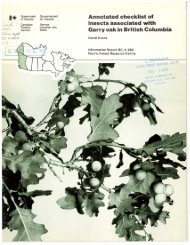
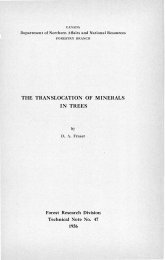
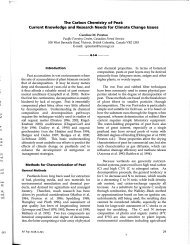


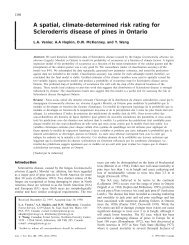

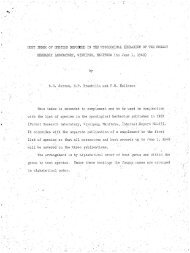
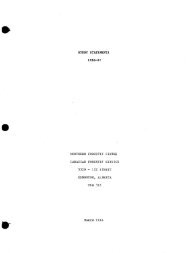
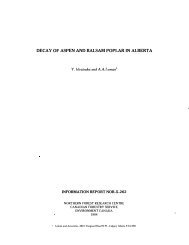
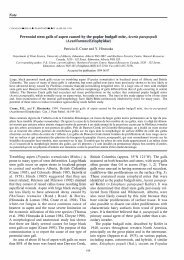
![Po],rell](https://img.yumpu.com/11946277/1/190x231/porell.jpg?quality=85)
